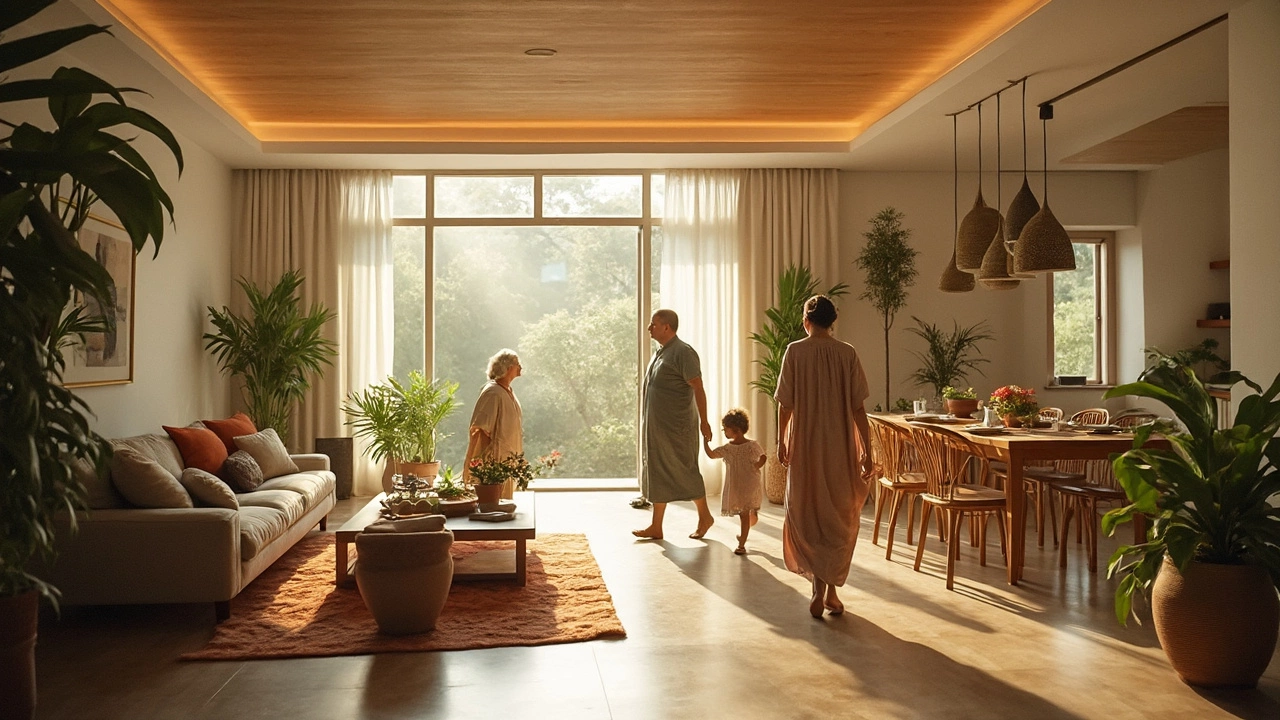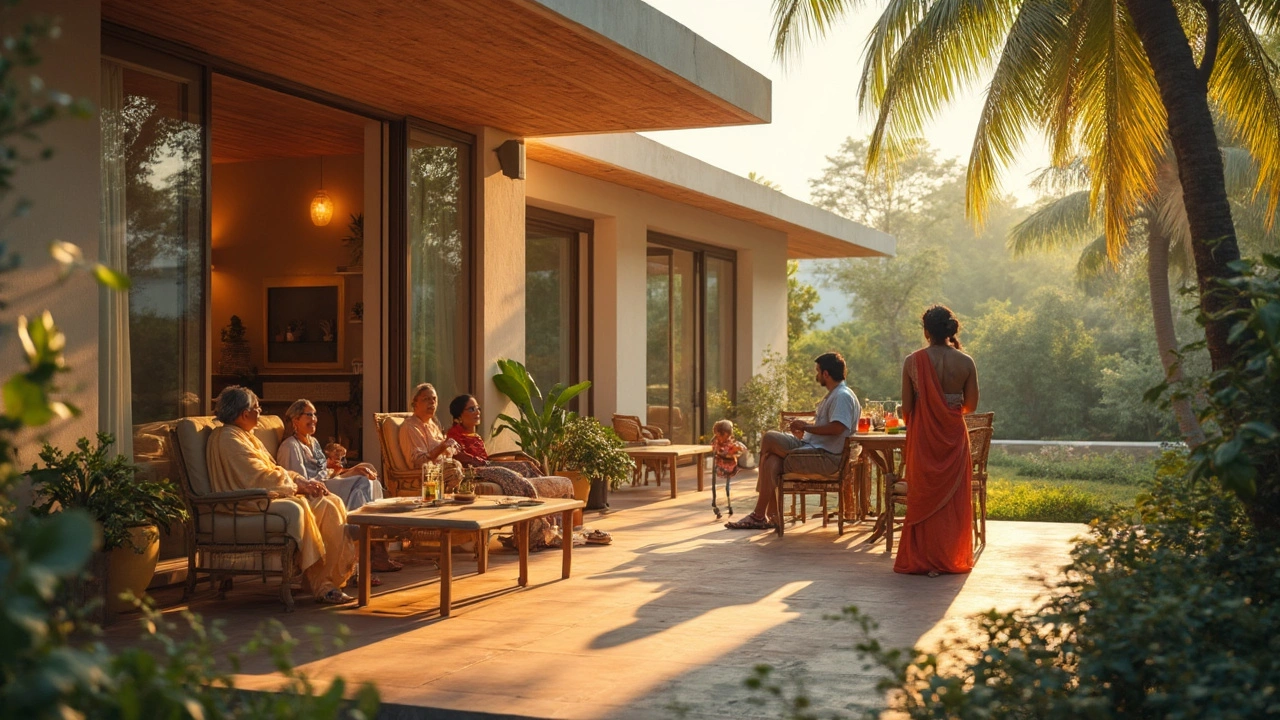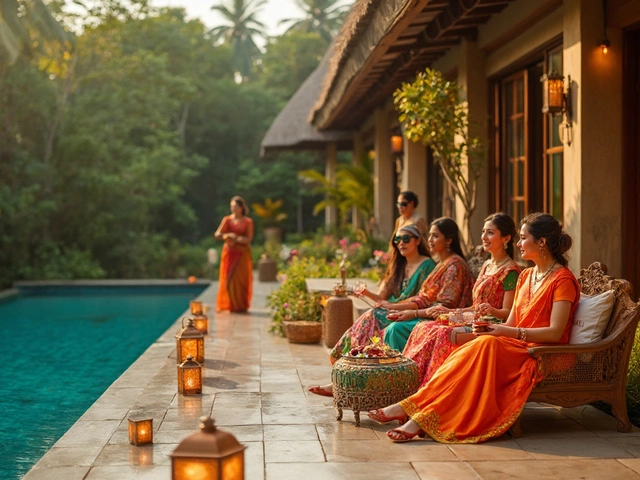Imagine never dragging groceries up a steep staircase again. That’s the life you get in a rambler style house. It’s all about easy living—everything you need is right there on one level.
A rambler isn’t a fancy real estate term—it’s just another name for a single-story house with a spread-out, open floor plan. Think big windows, sliding doors, and free-flowing spaces. There’s a reason you see them so much in neighborhoods built from the '50s through the '80s: people loved the mix of privacy and connection to the backyard. My cat Leo would have a field day running from one end straight to the sunny patio in seconds flat.
These homes are popping up again, mainly because they tick off lots of real-life boxes: accessible, easy to upgrade, and great for families or anyone who just isn’t into stairs. If you want a villa that feels practical but never boring, you’re looking in the right direction.
- What Actually Is a Rambler Style House?
- Key Features That Set Ramblers Apart
- Why Ramblers Are Loved (and Who Loves Them Most)
- Do Ramblers Work for Modern Life?
- Tips for Buying a Rambler
- Smart Upgrades to Make the Most of a Rambler
What Actually Is a Rambler Style House?
A rambler style house is just a one-story home, built to spread out horizontally instead of stacking rooms on top of each other. In the U.S., you’ll also hear people call them ranch homes or ranchers. This kind of house first started showing up big time in the late 1940s, mostly because people wanted more space and privacy after World War II. Flash forward, and these homes are still found everywhere, especially in the suburbs.
The layout makes a rambler easy to spot. Most have an open floor plan and long, low profiles that hug the ground. All main rooms—kitchen, living, bedrooms, and bathrooms—are on a single level. This design makes life simple, especially for families with young kids or anyone not thrilled about climbing stairs.
Rambler houses usually have these telltale features:
- One story with no full upper level
- Open concept living and dining areas
- Large picture windows to let in sunlight
- Direct access to outdoor spaces, like a deck or backyard
- Attached garages (pretty common, especially in newer builds)
Here’s a quick look at how rambler style house layouts stack up compared to other options:
| Home Style | Stories | Average Size (sq ft) | Main Draw |
|---|---|---|---|
| Rambler | 1 | 1,400 - 2,200 | Easy access, open layout |
| Colonial | 2-3 | 2,000 - 3,200 | Formal layout, upstairs bedrooms |
| Cape Cod | 1-1.5 | 1,100 - 1,700 | Compact, sloped roof |
Ramblers keep things straightforward. You won’t get lost or waste time running up and down stairs. And if you’re thinking long term, these homes are super practical for all stages of life.
Key Features That Set Ramblers Apart
The thing that jumps out first with a rambler style house is the single-story layout. No matter where you stand, you can usually see straight across the home. Forget the winding stairs you see in other villa types—ramblers stretch out horizontally, not vertically.
The floor plan is usually open. Kitchens, dining rooms, and living rooms all blend together. Instead of walls blocking off each space, you’ll get wide doorways or just one big area. That’s why they always feel roomy even if the square footage isn’t massive.
Most ramblers show off big windows and sliding glass doors, often leading right out to a patio or the backyard. This isn’t just a nice-to-have—it’s a real boost for natural light and easy outdoor access. If hosting a barbecue or letting pets zoom around outside is your thing, this layout nails it.
Here are some standout features you’ll spot in almost every rambler:
- Attached garages or carports, making grocery runs less of a pain.
- Wide hallways and doorways—good news if you have a stroller or a wheelchair.
- Low-pitched roofs and simple lines. No fancy peaks or towers here.
- Bedrooms tucked away on one side for peace and quiet.
- Efficient heating and cooling because everything is on one level.
It’s not just about looks. This design actually makes life easier. Take a look at some real-world basics that put the rambler side by side with other house styles:
| Feature | Rambler | Two-story villa |
|---|---|---|
| Average Size (sq ft) | 1,300-2,000 | 2,000-3,500 |
| Number of Stairs | None | 10-20 steps between floors |
| Natural Light | Lots (big windows, open floor plan) | Varies by floor |
| Outdoor Access | Direct from living areas | Usually first floor only |
Not everything’s perfect—ramblers usually need wider lots. But if you’re after stress-free living that flows, these features give them a real edge.
Why Ramblers Are Loved (and Who Loves Them Most)
There’s no mystery about why the rambler style house keeps making comebacks. They’re practical. No stairs means no tripping or carrying laundry up levels. For families with small kids or older folks who want to avoid steps, ramblers are hands-down the easiest kind of home to live in.
Open layouts are another hit. You get a straight line from the kitchen to the living space, which means it’s easy to chat while cooking or keep an eye on the kids (or, let’s be honest, the cat). Big windows and sliding doors let in plenty of sunshine, connecting indoor spaces directly to patios or gardens. Entertaining friends is simple—everyone can see and move around, instead of piling up in cramped hallways.
Ramblers aren’t just popular with retirees or families with toddlers anymore. Here’s a quick look at who’s buying them today:
- Young families – Wide play areas, easy supervision, no risky stairs.
- Retirees – Accessibility means they can age in place without expensive renos.
- Pet owners – Pet doors and immediate backyard access are game-changers (Leo loves it!).
- Renovators and flippers – The single-level design is easier to update and modernize.
Some studies from home listing sites suggest that homes with zero-step entries sell up to 19% faster. And according to the National Association of Home Builders, over 60% of buyers aged 55+ purposely choose single-story homes.
| Who Buys Ramblers? | Top Reason |
|---|---|
| Young Families | Safe, open space for kids; no stairs |
| Retirees | Easy accessibility; aging in place |
| Pet Owners | Quick yard access for animals |
| Renovators | Simpler layout for upgrades |
So, whether you have a busy household, mobility issues, or just prefer a simple layout, ramblers check a lot of boxes. They’re homes that match real-life needs, without the hassle of complicated designs. If you value everyday comfort and flexibility, you’ll probably get why ramblers never really go out of style.

Do Ramblers Work for Modern Life?
You might wonder if a rambler style house really fits today's way of living. After all, open layouts and single-story designs were all the rage when TVs had antennas. Does the style still make sense for busy families, remote workers, or people who love entertaining friends?
Absolutely—ramblers have actually become way more popular lately because our daily needs have changed. Lots of people want flexible, wide-open spaces now that working from home is common. Kids can play in the living room while the adults Zoom in the next room. There are no steps to worry about, making life easier whether you have toddlers or aging parents.
Let’s talk numbers. In 2024, over 48% of homebuyers aged 50+ specifically asked for single-story or accessible homes, according to data from the National Association of Realtors. That’s not just because of aging—people across all ages like the practicality.
| Feature | Modern Appeal |
|---|---|
| Open Layout | Great for multitasking and entertaining |
| Single-Level Living | No stairs, easier cleaning, safer for everyone |
| Easy Outdoor Access | Perfect for pet owners, kids, and quick BBQs |
| Update-Friendliness | Simple to add smart home tech or enlarge rooms |
If you buy a rambler, you can easily knock down walls (since it’s not holding up multiple stories), install wider doors, or add a high-tech kitchen. Plus, stuff like laundry, groceries, or moving heavy furniture just feels less annoying without stairs. Want solar panels? Ramblers’ roofs are usually perfect for them.
- Look for ramblers with attached garages. They’re super handy in rainy or hot places.
- Check if the home has wide halls and step-free entries—those are future-proof if mobility changes.
- If outdoor space matters, ramblers usually have sliding doors straight to the garden or patio.
So yeah, ramblers are versatile and ready for modern living, whether you need office space, safe spots for kids, or a place to host Friday night get-togethers without anyone worrying about stairs.
Tips for Buying a Rambler
Ready to buy a rambler? Before you jump in, keep a few practical things in mind so you get a house that works for real life. Rambler-style homes can look simple, but there’s detail to check under the hood.
- Check the foundation and roof. These homes spread out wide, so the roof and slab support matter a lot. Walk around and look for cracks or sagging, especially if the house is built in the '60s or '70s.
- Look at the windows and sliding doors. Older ramblers often have dated single-pane glass, which leaks air like crazy. Newer energy-efficient windows will cut your future power bills.
- Get a feel for the layout. Since rambler style houses run long and open, some have awkward hallways or cut-up floor plans from past remodels. Bring a tape measure and imagine your furniture in the space.
- Yard size matters. A classic rambler usually comes with a nice backyard or side yard. If outdoor space is key for you (or your pets—my cat Leo would agree), double check the property boundaries on the listing map.
- Make sure the plumbing and electrical systems are up to code. You don’t want to face surprises after you move in, especially since many ramblers are now over 50 years old.
It’s also a good idea to compare recent sales. Here’s what single-story ramblers were going for earlier this year in a few U.S. cities:
| City | Median Rambler Price (Q1 2025) | Typical Lot Size (sq ft) |
|---|---|---|
| Dallas, TX | $425,000 | 9,100 |
| Portland, OR | $500,000 | 6,800 |
| Phoenix, AZ | $412,000 | 8,300 |
One last tip: rambler homes sell fast in areas with lots of older adults or families with young kids, since that no-stairs feature is a real draw. Act quick if you see a good one that checks your boxes for price and layout. Bring your questions and maybe a smart inspector who knows the difference between a quirky mid-century quirk and an actual dealbreaker.
Smart Upgrades to Make the Most of a Rambler
The best part of owning a rambler is how easy it is to update. Because there’s a simple floor plan and everything stays on one level, you can really open up the space without worrying about moving stairs or beams. Here’s what really makes a difference for a rambler style house today:
- Open Up the Living Spaces: Most ramblers already have decent flow, but if there are still chunky walls, busting them out can bring loads of daylight through the whole home. Knock out that wall between the kitchen and living area for one huge great room.
- Go Big on Windows and Doors: Modern buyers love sunlight and backyard views. Swapping out old, small windows for big sliders or even folding glass walls can make a basic rambler feel like a high-end villa.
- Boost Energy Efficiency: Ramblers from the 60s or 70s are rarely insulated well. Add attic insulation, double-pane windows, and updated HVAC. The U.S. Department of Energy claims proper insulation can cut heating and cooling costs by about 15%—money back in your pocket fast.
- Accessible Baths: One-level living is perfect for aging in place, but older ramblers often have tiny bathrooms. Pull out that tub for a big walk-in shower and widen the doors if you’re thinking long-term.
- Smart Home Upgrades: Set up a smart thermostat, security system, and modern lighting; half the fun of a rambler is how seamlessly you can add tech without routing wires up and down stairs.
Thinking about what adds the most value? Check out this quick guide based on 2024 renovation data from Remodeling Magazine. Numbers show the percentage of cost homeowners typically get back when they sell.
| Upgrade | Typical Cost Recouped (%) |
|---|---|
| Window Replacement | 69% |
| Minor Kitchen Remodel | 85% |
| Bathroom Upgrade | 60% |
| Attic Insulation | 83% |
| Smart Tech Install | Varies—good selling point, but depends on market |
If you’re not moving soon, stick to changes that make life better now—the value boost is just a bonus. And remember, ramblers make it easy to add stuff outside too, like patios or even a tiny catio (Leo’s dream, honestly). No need to overthink—just focus on changes that make your daily life smoother and more fun.






